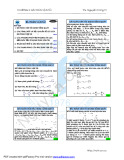
Subgradients
Hoàng Nam Dũng
Khoa Toán - Cơ - Tin học, Đại học Khoa học Tự nhiên, Đại học Quốc gia Hà Nội

Last time: gradient descent
Consider the problem
min
xf(x)
for fconvex and differentiable, dom(f) = Rn.
Gradient descent: choose initial x(0)∈Rn, repeat
x(k)=x(k−1)−tk· ∇f(x(k−1)),k=1,2,3, . . .
Step sizes tkchosen to be fixed and small, or by backtracking line
search
If ∇fLipschitz, gradient descent has convergence rate O(1/ε)
Downsides:
◮Requires fdifferentiable
◮Can be slow to converge
1

Outline
Today:
◮Subgradients
◮Examples
◮Properties
◮Optimality characterizations
2

Basic inequality
Recall that for convex and differentiable f,
f(y)≥f(x) + ∇f(x)T(y−x),∀x,y∈dom(f).
(x, f(x))
∇f(x)
−1
◮The first-order approximation of fat xis a global lower
bound.
◮∇fdefines a non-vertical supporting hyperplane to epi(f)at
(x,f(x))
∇f−1 y
t!− x
f(x)!!≤0,∀(y,t)∈epi(f).3

Subgradients
Asubgradient of a convex function fat xis any g∈Rnsuch that
f(y)≥f(x) + gT(y−x),∀y∈dom(f).
◮Always exists (on the relative interior of dom(f))
◮If fdifferentiable at x, then g=∇f(x)uniquely
◮Same definition works for nonconvex f(however, subgradients
need not exist).
4

![Đề cương bài giảng Các phép toán tối ưu [mới nhất]](https://cdn.tailieu.vn/images/document/thumbnail/2021/20210303/gaocaolon10/135x160/3121614754463.jpg)























![Quyển ghi Xác suất và Thống kê [chuẩn nhất]](https://cdn.tailieu.vn/images/document/thumbnail/2025/20251030/anh26012006/135x160/68811762164229.jpg)
